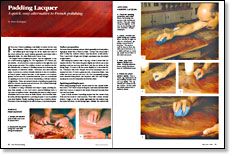
Synopsis: When done well, a French polish has a soft but brilliant glow that brings out all the depth and color of the wood without the heavy buildup generally associated with a high-gloss finish. No other finish comes close for Mario Rodriguez, who’s taught French polishing for years. The ingredients – shellac, oil, and pumice – must be applied at the right time and in the proper amounts. The method explained here produces a finish virtually identical to that of a traditional French polish without the risks, though it still requires a lot of elbow grease. Rodriguez talks about preparing the surface, applying the padding lacquer, feathering out the finish, repairing mistakes, and finishing on the lathe. There is also a discussion of filling pores for a glass-smooth surface.
For me, French polishing is the finish of choice for the very finest furniture. When done well, a French polish has a soft but brilliant glow that brings out all the depth and color of the wood without the heavy buildup generally associated with a high-gloss finish. No other finish even comes close.
I’ve taught French polishing for years, and for beginners, it can be a nerve-racking juggling act. The ingredients of a French polish—shellac, oil and pumice—must be applied at the right time and in the proper amounts. The addition of each can improve the finish dramatically—or destroy it. Padding lacquer is an amazing onestep mixture of dissolved shellac, lubricants and nitrocellulose resins. It produces a surface virtually identical to that of a traditional French polish, without the risks. It still requires a lot of elbow grease, but because it’s a premixed formula, you can concentrate on applying it and not worry about maintaining a delicate balance of ingredients. There are several brands of padding lacquers from which to choose (see the sources box on p. 50). I haven’t found significant differences among them.
In addition to being convenient and easy to apply, padding lacquer dries quickly, so you don’t need a special finishing room. It can even be applied on-site, eliminating the need to bring a piece of furniture back to the shop for finish repairs. And because shellac is the primary ingredient in a padding lacquer, it can be applied over other finishes. Finally, padding lacquer has a variable sheen. The more or less sanding you do will increase or decrease its gloss.
Surface preparation
For more formal furniture pieces, which generally look best with a high-gloss finish like a French polish, I scrape the wood until I have a fairly flat, uniform surface (see the photo at left below). Then I sand with 220-grit and 320-grit sandpaper (see the photo at right below).
After wiping the surface with a dry rag, I wash it down with denatured alcohol. This raises the grain slightly and allows me to see sanding scratches and any other flaws (see the top photo on the facing page). If I want to fill the pores slightly for a smoother finish, I wet-sand with worn 320-grit wet-or-dry sandpaper and denatured alcohol. If I want a glass-smooth, nonporous finish, I use a filler (for more, see the box on p. 50). For a moderately porous, more natural-looking finish, just dry-sand with 320- and 400-grit sandpapers once the denatured alcohol has dried.
From Fine Woodworking #118
For the full article, download the PDF below:
Fine Woodworking Recommended Products

Jorgensen 6 inch Bar Clamp Set, 4 Pack

Veritas Micro-Adjust Wheel Marking Gauge

Veritas Standard Wheel Marking Gauge























Log in or create an account to post a comment.
Sign up Log in